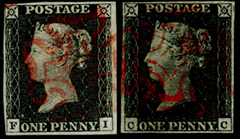 First Issues Collectors Club
of stamps and philatelic material
First Issues Collectors Club
of stamps and philatelic material
Home - Catalog - Categories - Index - Journal - Exhibits - Auctions - Forgeries - Join
 First Issues Collectors Club
of stamps and philatelic material
First Issues Collectors Club
of stamps and philatelic material
Home - Catalog - Categories - Index - Journal - Exhibits - Auctions - Forgeries - Join
| first issues > glossary |
This page will contain definitions and explanations of some of the technical terms in philately.
| Term | Meaning |
|---|---|
| Acknowledgement of Receipt | Prepayment for an acknowledgement of receipt of a registered package. Some countries issued a stamp to show payment, the first being Columbia. |
| Burélage | A fine pattern of lines or dots printed underneath the design on the front or back of the stamp as a security device. It was first used by Denmark. |
| Interpanneau | Interpanneau is French for 'gutter'. An interpanneau pair is two stamps with a gutter between them. |
| Paper types |
|
| Perforations | Early stamps were imperforate and had to be cut from a larger sheet. Perforations, a series of holes between the stamps, allows them to be separated easily by hand. The process of perforation involves small discs of paper being removed, as distinct from rouletting, where the spaces between stamps are pierced or intermittently cut. With self-adhesive stamps the paper between the stamps is usually removed completely. Wikipedia states, “The standard for describing perforation is the number of holes (or the "teeth" or perfs of an individual stamp) in a 2-centimeter span. The finest gauge ever used is 18 on stamps of the Malay States in the early 1950s, and the coarsest is 2, seen on the 1891 stamps of Bhopal.” When specifying perforations, if the horizontal and vertical are different (sometimes called 'compound'), the horizontal is stated first (e.g. 12x11). This link shows how to use a perforation gauge. |
| Postal agency / post office | |
| Printing methods | In all but the most primitive methods for a stamp to be printed an original design must be produced and then reduced in size, reversed and multiplied onto a plate that is used to print a sheet of stamps. There are four main methods of producing a plate.
|
| Rouletting | see perforation |
| Suzerainty | Most of these definitions are philatelic, but this one is political. It crops up several times in these pages, including those for Egypt and Korea. Wikipedia, "Suzerainty is a situation in which a powerful region or people controls the foreign policy and international relations of a tributary vassal state while allowing the subservient nation internal autonomy. The dominant entity in the suzerainty relationship, or the more powerful entity itself, is called a suzerain. The term suzerainty was originally used to refer to the relationship between the Ottoman Empire and its surrounding regions. It differs from sovereignty in that the tributary enjoys some (often limited) self-rule." [accessed 4th July 2016]. |
text